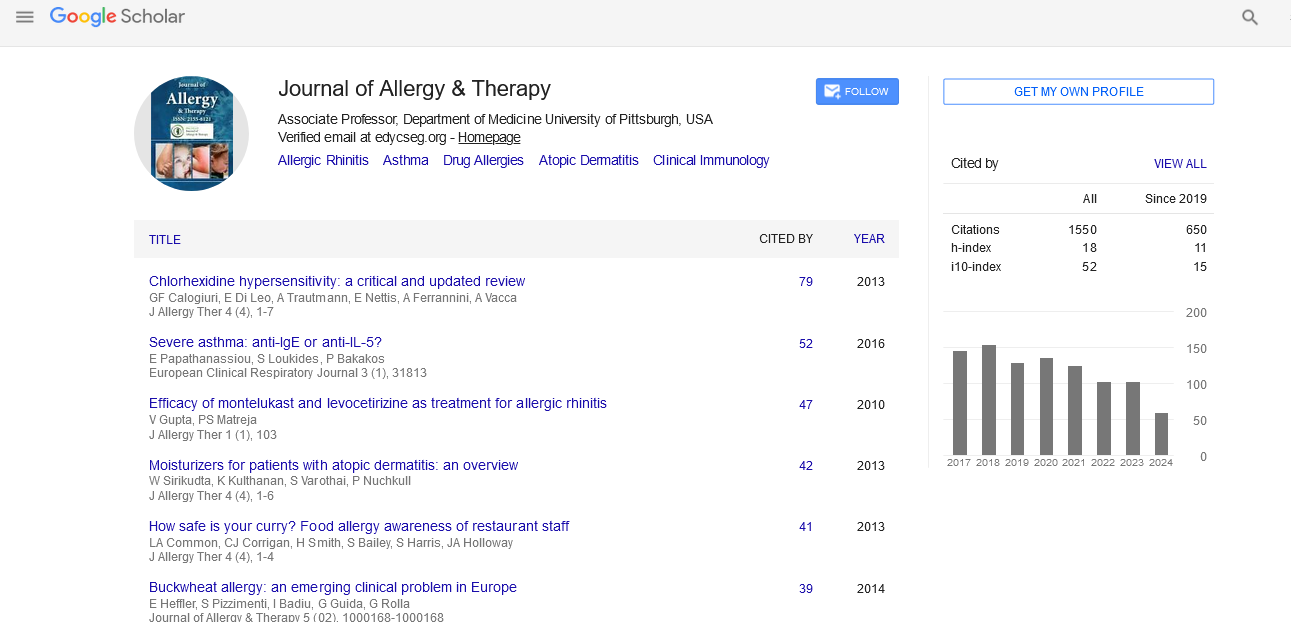Indexed In
- Academic Journals Database
- Open J Gate
- Genamics JournalSeek
- Academic Keys
- JournalTOCs
- China National Knowledge Infrastructure (CNKI)
- Ulrich's Periodicals Directory
- Electronic Journals Library
- RefSeek
- Hamdard University
- EBSCO A-Z
- OCLC- WorldCat
- SWB online catalog
- Virtual Library of Biology (vifabio)
- Publons
- Geneva Foundation for Medical Education and Research
- Euro Pub
- Google Scholar
Useful Links
Share This Page
Journal Flyer

Open Access Journals
- Agri and Aquaculture
- Biochemistry
- Bioinformatics & Systems Biology
- Business & Management
- Chemistry
- Clinical Sciences
- Engineering
- Food & Nutrition
- General Science
- Genetics & Molecular Biology
- Immunology & Microbiology
- Medical Sciences
- Neuroscience & Psychology
- Nursing & Health Care
- Pharmaceutical Sciences
Opinion Article - (2023) Volume 14, Issue 2
Causes of Bronchial Asthma Virus Infection in Childrens
Ching Huge*Received: 03-Feb-2023, Manuscript No. JAT-23-20287; Editor assigned: 06-Feb-2023, Pre QC No. JAT-23-20287 (PQ); Reviewed: 20-Feb-2023, QC No. JAT-23-20287; Revised: 27-Feb-2023, Manuscript No. JAT-23-20287 (R); Published: 06-Mar-2023, DOI: 10.35248/2155-6121.23.14.338
Description
Chronic bronchial asthma, such as corticosteroid-resistant asthma, is difficult to control. Bronchial asthma is closely related to T cells. Additionally, it has been proposed that bronchial asthma could be effectively treated with immunosuppressive drugs that suppress T cells. Recently, in rare instances of severe bronchial asthma, immunosuppressive medications have been used. This case report reports a patient with severe bronchial asthma who also had neutrophil infiltration causing airway inflammation that might be managed by tacrolimus treatment.
Asthma symptoms in the lungs increased during hospitalization. Laboratory tests showed no peripheral blood eosinophil’s and serum lactate dehydrogenase levels of 287 International Units (IU) per liter, less than 1.3 IU per milliliter of Myeloperoxidase Anti Neutrophil Cytoplasmic Antibody (MPO-ANCA), and 635 IU per milliliter of IgE. While her prednisolone dosage was increased to 20 mg per day, she still required oxygen inhalation due to dyspnea, wheezing, and hypoxia. Despite the increase in prednisolone, this aggravation of her bronchial asthma remained for a month. She was then given 300 mg of omalizumab daily, but her dyspnea remained and a chest radiograph revealed left lung atelectasis they had a CRP level of 0.27 mg/l. The relationship between a patient's physical growth, nutritional status, and disease course characteristics has received a lot of attention in recent years. It is specifically examined whether children and teenagers with Bronchial Asthma (BA) may experience a slowdown in their body growth, which is the primary indicator of physical development.
Bronchial toileting did not alleviate the atelectasis since there was a significant amount of viscous sputum in the peripheral bronchi. Suction specimens of the sputum, which contained 82% neutrophils and 18% lymphocytes, did not reveal any eosinophil’s or cancerous cells, and sputum cultures did not reveal any bacteria or fungi. Prednisolone dosage was raised to 120 mg daily for three days before being reduced to 60 mg daily for the duration of the hospital stay. For two weeks, prednisolone therapy was given concurrently with the carbapenem antibiotic panipenem/betamipron. The patient's atelectasis did not get better, either, and she continued to exhibit severe dyspnea, wheezing, and hypoxia that required the inhalation of a lot of oxygen. She had 2 mg per day of treatment a month later. Chronic airway inflammation with inflammatory cell infiltration, such as that caused by eosinophil, is the core pathophysiology of bronchial asthma.
In contrast to asthmatics whose condition is under control, those with severe disease typically exhibit neutrophil inflammation. The importance of neutrophil inflammation is unclear, but there is a correlation between increased severity in a subset of severe asthma cases and neutrophil inflammation that is not controlled by corticosteroid therapy. Many neutrophils but no eosinophil was seen in the suction sputum samples taken during bronchoscopy from the current patient. The patient's severe neutrophilic inflammation-related asthma was therefore evident. An inflammatory drug is tacrolimus. This medication's capacity to suppress calcineurin in T cells gives it a similar method of action as cyclosporine. There have been a few reports of earlier human investigations on steroid-dependent asthma treated with oral cyclosporine. These findings imply that while cyclosporine may not be useful in all people with steroiddependent asthma, it could potentially be effective for several.
Citation: Huge C (2023) Causes of Bronchial Asthma Virus Infection in Childrens. J Allergy Ther. 14:338.
Copyright: © 2023 Huge C. This is an open access article distributed under the terms of the Creative Commons Attribution License, which permits unrestricted use, distribution, and reproduction in any medium, provided the original author and source are credited.


